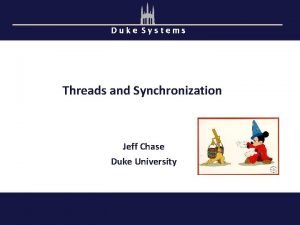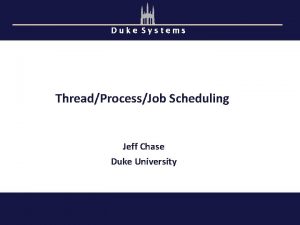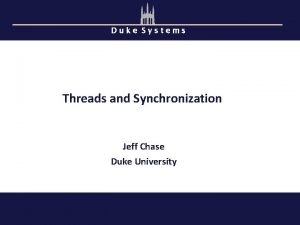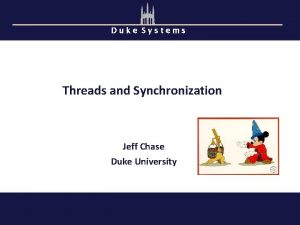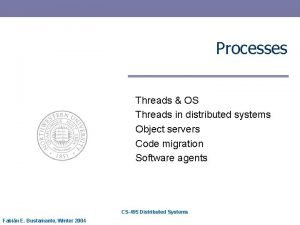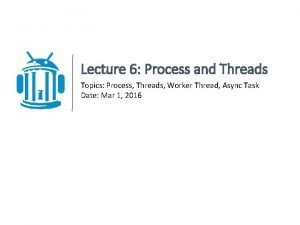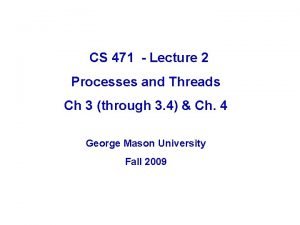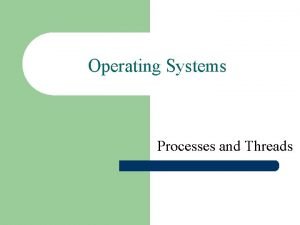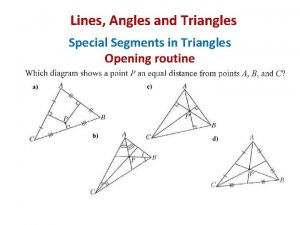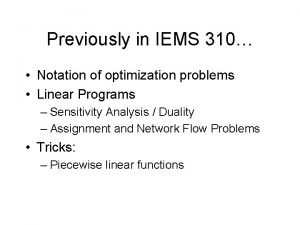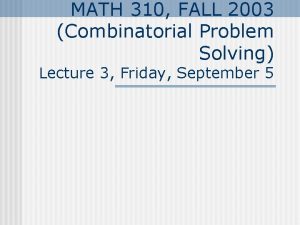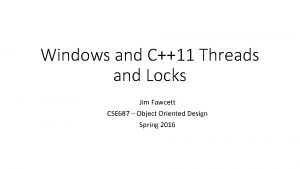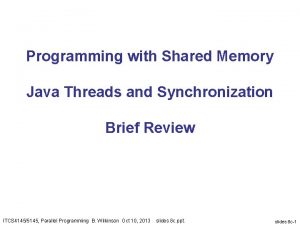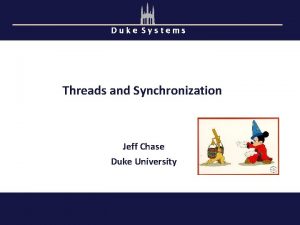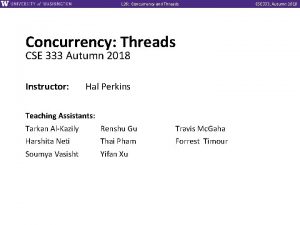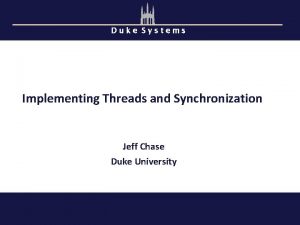Duke Systems CPS 310 Threads and Concurrency Jeff

























![Pthread (posix thread) example int main(int argc, char *argv[]) { if (argc != 2) Pthread (posix thread) example int main(int argc, char *argv[]) { if (argc != 2)](https://slidetodoc.com/presentation_image/26e01dc35b2f05aa07d939b0b5fb4b74/image-26.jpg)




































- Slides: 62

Duke Systems CPS 310 Threads and Concurrency Jeff Chase Duke University http: //www. cs. duke. edu/~chase/cps 310

Threads • A thread is a stream of control…. I draw my threads like this. – Executes a sequence of instructions. – Thread identity is defined by CPU register context (PC, SP, …, page table base registers, …) – Generally: a thread’s context is its register values and referenced memory state (stacks, page tables). • Multiple threads can execute independently: – They can run in parallel on multiple cores. . . • physical concurrency – …or arbitrarily interleaved on some single core. • logical concurrency • A thread is also an OS abstraction to spawn and manage a stream of control. Some people draw threads as squiggly lines. 310

Portrait of a thread In an implementation, each thread is represented by a data struct. We call it a “thread object” or “Thread Control Block”. It stores information about the thread, and may be linked into other system data structures. “Heuristic fencepost”: try to detect stack overflow errors Thread Control Block (“TCB”) Storage for context (register values) when thread is not running. name/status etc 0 xdeadbeef ucontext_t Stack Each thread also has a runtime stack for its own use. As a running thread calls procedures in the code, frames are pushed on its stack.

Processes and their threads virtual address space + Each process has a virtual address space (VAS): a private name space for the virtual memory it uses. The VAS is both a “sandbox” and a “lockbox”: it limits what the process can see/do, and protects its data from others. main thread stack other threads (optional) +… Each process has a main thread bound to the VAS, with a stack. On real systems, a process can have multiple threads. If we say a process does something, we really mean its thread does it. We presume that they can all make system calls and block independently. The kernel can suspend/restart a thread wherever and whenever it wants. STOP wait

Two threads sharing a CPU/core concept reality context switch

Thread Abstraction • Infinite number of processors • Threads execute with variable speed – Programs must be designed to work with any schedule

Possible Executions These executions are “schedules” chosen by the system.

Thread APIs (rough/pseudocode) • Every thread system has an API for applications to use to manage their threads. Examples: Pthreads, Java threads, C#, Taos… – Create and start (“spawn” or “generate”) a thread. – Wait for a thread to complete (exit), and obtain a return value. – Break into the execution of a thread (optional). – Save and access data specific to each thread. • References to thread objects may be passed around in the API. Thread operations (parent) a rough sketch: t = create(); t. start(proc, argv); t. alert(); (optional) result = t. join(); (wait) Details vary. Self operations (child) a rough sketch: exit(result); yield(); t = self(); setdata(ptr); ptr = selfdata(); alertwait(); (optional)

Threads lab (due 2/25) #define STACK_SIZE 262144 /* size of each thread's stack */ typedef void (*thread_startfunc_t) (void *); extern int thread_libinit(thread_startfunc_t func, void *arg); extern int thread_create(thread_startfunc_t func, void *arg); extern int thread_yield(void);

Shared vs. Per-Thread State

Thread context switch out switch in Virtual memory x program code library data R 0 CPU (core) 1. save registers Rn PC SP y x y registers stack 2. load registers stack Running code can suspend the current thread just by saving its register values in memory. Load them back to resume it at any time.

Programmer vs. Processor View

Example: Unix fork The Unix fork() system call creates/launches a new thread, in its own fresh virtual address space: it creates a new process. (Thread + VAS == Process. ) Strangely, the new (“child”) process is an exact clone of the calling (“parent”) process. fork Oh Ghost of Walt, please don’t sue me.

Unix fork/exit syscalls int pid = fork(); Create a new process that is a clone of its parent. Return child process ID (pid) to parent, return 0 to child. parent fork parent child time exit(status); Exit with status, destroying the process. Status is returned to the parent. Note: this is not the only way for a process to exit! data exit data p pid: 5587 pid: 5588

fork The fork syscall returns twice: int pid; int status = 0; if (pid = fork()) { /* parent */ …. . } else { /* child */ …. . exit(status); } It returns a zero in the context of the new child process. It returns the new child process ID (pid) in the context of the parent.

wait syscall int pid; int status = 0; if (pid = fork()) { /* parent */ …. . pid = wait(&status); } else { /* child */ …. . exit(status); } Parent uses wait to sleep until the child exits; wait returns child pid and status. Wait variants allow wait on a specific child, or notification of stops and other “signals”. Recommended: use waitpid().

wait Process states (i. e. , states of the main thread of the process) “wakeup” “sleep” Note: in modern Unix systems the wait syscall has many variants and options.

A simple program: parallel … int main(…arg N…) { for 1 to N dofork(); for 1 to N wait(…); } void child() { BUSYWORK {x = v; } exit(0); } … Parallel creates N child processes and waits for them all to complete. Each child performs a computation that takes, oh, 10 -15 seconds, storing values repeatedly to a global variable, then it exits. How does N affect completion time? chase$ cc –o parallel. c chase$. /parallel ? ? ? chase$

A simple program: parallel 70000 Three different machines 60000 50000 Completion time (ms) 40000 30000 20000 10000 0 0 5 10 15 20 N (# of children) 25 30

Parallel: some questions • Which machine is fastest? • How does the total work grow as a function of N? • Does completion time scale with the total work? Why? • Why are the lines flatter for low values of N? • How many cores do these machines have? • Why is the timing roughly linear, even for “odd” N? • Why do the lines have different slopes? • Why would the completion time ever drop with higher N? • Why is one of the lines smoother than the other two? • Can we filter out the noise?

Thread states and transitions If a thread is in the ready state thread, then the system may choose to run it “at any time”. The kernel can switch threads whenever it gains control on a core, e. g. , by a timer interrupt. If the current thread takes a fault or system call trap, and blocks or exits, then the scheduler switches to another thread. But it could also preempt a running thread. From the point of view of the program, dispatch and preemption are nondeterministic: we can’t know the schedule in advance. running sleep blocked waiting STOP wait wakeup yield preempt dispatch ready These preempt and dispatch transitions are controlled by the kernel scheduler. Sleep and wakeup transitions are initiated by calls to internal sleep/wakeup APIs by a running thread.

Thread Lifecycle

What cores do Idle loop scheduler get. Next. To. Run() nothing? get thread got thread put thready queue (runqueue) switch in idle pause sleep? exit? timer quantum expired? switch out run thread

What causes a context switch? There are three possible causes: 1. Preempt (yield). The thread has had full use of the core for long enough. It has more to do, but it’s time to let some other thread “drive the core”. – E. g. , timer interrupt, quantum expired OS forces yield – Thread enters Ready state, goes into pool of runnable threads. 2. Exit. Thread is finished: “park the core” and die. 3. Block/sleep/wait. The thread cannot make forward progress until some specific occurrence takes place. – Thread enters Blocked state, and just lies there until the event occurs. (Think “stop sign” or “red light”. ) STOP wait

Two threads call yield
![Pthread posix thread example int mainint argc char argv if argc 2 Pthread (posix thread) example int main(int argc, char *argv[]) { if (argc != 2)](https://slidetodoc.com/presentation_image/26e01dc35b2f05aa07d939b0b5fb4b74/image-26.jpg)
Pthread (posix thread) example int main(int argc, char *argv[]) { if (argc != 2) { fprintf(stderr, "usage: threads <loops>n"); exit(1); void *worker(void *arg) { } int i; loops = atoi(argv[1]); for (i = 0; i < loops; i++) { pthread_t p 1, p 2; counter++; printf("Initial value : %dn", counter); } pthread_create(&p 1, NULL, worker, NULL); pthread_exit(NULL); pthread_create(&p 2, NULL, worker, NULL); } pthread_join(p 1, NULL); pthread_join(p 2, NULL); data printf("Final value : %dn", counter); return 0; } volatile int counter = 0; int loops; [pthread code from OSTEP]

Reading Between the Lines of C load add store x, R 2, 1, R 2, x load add store ; load global variable x ; increment: x = x + 1 ; store global variable x Two threads execute this code section. x is a shared variable. Two executions of this code, so: x is incremented by two. ✔ load add store

Interleaving matters load add store x, R 2, 1, R 2, x load add store ; load global variable x ; increment: x = x + 1 ; store global variable x Two threads execute this code section. x is a shared variable. load add store X In this schedule, x is incremented only once: last writer wins. The program breaks under this schedule. This bug is a race.

Resource Trajectory Graphs Resource trajectory graphs (RTG) depict the “random walk” through the space of possible program states. Sn RTG is useful to depict all possible executions of multiple threads. I draw them for only two threads because slides are two-dimensional. RTG for N threads is N-dimensional. Thread i advances along axis i. Each point represents one state in the set of all possible system states. Cross-product of the possible states of all threads in the system Sm So

Resource Trajectory Graphs This RTG depicts a schedule within the space of possible schedules for a simple program of two threads sharing one core. Blue advances along the y-axis. Every schedule ends here. EXIT The diagonal is an idealized parallel execution (two cores). Purple advances along the x-axis. The scheduler chooses the path (schedule, event order, or interleaving). context switch EXIT Every schedule starts here. From the point of view of the program, the chosen path is nondeterministic.

A race This is a valid schedule. But the schedule interleaves the executions of “x = x+ 1” in the two threads. The variable x is shared (like the counter in the pthreads example). x=x+1 start This schedule can corrupt the value of the shared variable x, causing the program to execute incorrectly. x=x+1 This is an example of a race: the behavior of the program depends on the schedule, and some schedules yield incorrect results.

The need for mutual exclusion x=? ? ? x=x+1 The program may fail if the schedule enters the grey box (i. e. , if two threads execute the critical section concurrently). The two threads must not both operate on the shared global x “at the same time”.

Using a lock/mutex R A lock (mutex) prevents the schedule from ever entering the grey box, ever: both threads would have to hold the same lock at the same time, and locks don’t allow that. x=? ? ? x=x+1 A A x=x+1 The program may fail if it enters the grey box. R

“Lock it down” context switch A thread acquires (locks) the designated mutex before operating on a given piece of shared data. R x=x+1 The thread holds the mutex. At most one thread can hold a given mutex at a time (mutual exclusion). A start Use a lock (mutex) to synchronize access to a data structure that is shared by multiple threads. A x=x+1 R Thread releases (unlocks) the mutex when done. If another thread is waiting to acquire, then it wakes. The mutex bars entry to the grey box: the threads cannot both hold the mutex.

OSTEP pthread example (2) pthread_mutex_t m; volatile int counter = 0; int loops; A “Lock it down. ” void *worker(void *arg) { int i; for (i = 0; i < loops; i++) { Pthread_mutex_lock(&m); counter++; Pthread_mutex_unlock(&m); } pthread_exit(NULL); } A R R load add store

Concurrency control • The scheduler (and the machine) select the execution order of threads • Each thread executes a sequence of instructions, but their sequences may be arbitrarily interleaved. – E. g. , from the point of view of loads/stores on memory. • Each possible execution order is a schedule. • A thread-safe program must exclude schedules that lead to incorrect behavior. • It is called synchronization or concurrency control.

This is not a game But we can think of it as a game. x=x+1 1. You write your program. 2. The game begins when you submit your program to your adversary: the scheduler. 3. The scheduler chooses all the moves while you watch. 4. Your program may constrain the set of legal moves. 5. The scheduler searches for a legal schedule that breaks your program. 6. If it succeeds, then you lose (your program has a race). 7. You win by not losing.

A Lock or Mutex Locks are the basic tools to enforce mutual exclusion in conflicting critical sections. • A lock is a special data item in memory. • API methods: Acquire and Release. A • Also called Lock() and Unlock(). R A • Threads pair calls to Acquire and Release. • Acquire upon entering a critical section. R • Release upon leaving a critical section. • Between Acquire/Release, the thread holds the lock. • Acquire does not pass until any previous holder releases. • Waiting locks can spin (a spinlock) or block (a mutex). • Also called a monitor: threads enter (acquire) and exit (release).

Definition of a lock (mutex) • Acquire + release ops on L are strictly paired. – After acquire completes, the caller holds (owns) the lock L until the matching release. • Acquire + release pairs on each L are ordered. – Total order: each lock L has at most one holder at any given time. – That property is mutual exclusion; L is a mutex.

New Problem: Ping-Pong void Ping. Pong() { while(not done) { … if (blue) switch to purple; if (purple) switch to blue; } }

Ping-Pong with Mutexes? void Ping. Pong() { while(not done) { Mx->Acquire(); … Mx->Release(); } } ? ? ?

Mutexes don’t work for ping-pong

Waiting for conditions • Ping-pong motivates more general synchronization primitives. • In particular, we need some way for a thread to sleep until some other thread wakes it up. • This enables explicit signaling over any kind of condition, e. g. , changes in the program state or state of a shared resource. • Ideally, the threads don’t have to know about each other explicitly. They should be able to coordinate around shared objects. States and transitions for thread T 1 running T 1 sleeps blocked T 2 wakes up T 1 Scheduler: dispatch/preempt T 1 ready

Waiting for conditions • In particular, a thread might wait for some logical condition to become true. A condition is a predicate over state: it is any statement about the “world” that is either true or false. – Wait until a new event arrives; wait until event queue is not empty. – Wait for certain amount of time to elapse, then wake up at time t. – Wait for a network packet to arrive or an I/O operation to complete. – Wait for a shared resource (e. g. , buffer space) to free up. – Wait for some other thread to finish some operation (e. g. , initializing). States and transitions for thread T 1 running T 1: wait on X blocked T 2: signal/notify on X Scheduler controls these transitions ready

Condition variables • A condition variable (CV) is an object with an API. – wait: block until some condition becomes true • Not to be confused with Unix wait* system call – signal (also called notify): signal that the condition is true • Wake up one waiter. • Every CV is bound to exactly one mutex, which is necessary for safe use of the CV. – The mutex protects shared state associated with the condition • A mutex may have any number of CVs bound to it. • CVs also define a broadcast (notify. All) primitive. – Signal all waiters.

Lab #1 API int thread_lock(unsigned int lock) int thread_unlock(unsigned int lock) int thread_wait(unsigned int lock, unsigned int cond) int thread_signal(unsigned int lock, unsigned int cond) int thread_broadcast(unsigned int lock, unsigned int cond) A lock is identified by an unsigned integer (0 - 0 xffff). Each lock has a set of condition variables associated with it (numbered 0 - 0 xffff), so a condition variable is identified uniquely by the tuple (lock number, cond number). Programs can use arbitrary numbers for locks and condition variables (i. e. , they need not be numbered from 0 - n).

Ping-Pong using a condition variable void Ping. Pong() { mx->Acquire(); while(not done) { … cv->Signal(); cv->Wait(); } mx->Release(); }

Waiting for conditions • You can use condition variables (CVs) to represent any condition in your program (Q empty, buffer full, op complete, resource ready…). – We can use CVs to implement any kind of synchronization object. • Associate the condition variable with the mutex that protects the state relating to that condition! – Note: CVs are not variables. But you can associate them with whatever data you want, i. e, the state protected by its mutex. • A caller of CV wait must hold its mutex (be “in the monitor”). – This is crucial because it means that a waiter can wait on a logical condition and know that it won’t change until the waiter is safely asleep. – Otherwise, due to nondeterminism, another thread could change the condition and signal before the waiter is asleep! The waiter would sleep forever: the missed wakeup or wake-up waiter problem. • Wait atomically releases the mutex to sleep, and reacquires it before returning.

A note on the terms “wait” and “signal” Don’t confuse CV wait() with the Unix wait* system call. Also, don’t confuse CV signal() with Unix signals. It is easy to confuse concepts when they have the same name. The similarity of names is not an accident. Both kinds of “wait” put the calling thread to sleep until some other thread notifies it of a particular condition or event. And both kinds of “signal” are ways to notify a thread that something of interest has happened, so that it can respond. In the case of wait* syscall, the condition or event to wait for is specifically an exit (or other change of status) of a child process. CV wait is more general: it can be used to implement wait/signal behavior for any kind of condition, for any kind of synchronization object, including but not limited to the internal implementation of the wait* syscalls. Note that a wait* syscall does not always put the calling thread to sleep. For example, waitpid() syscall with the WNOHANG option does not put the caller to sleep. There are other cases in which a wait* syscall does not wait. (Refer to the manpage or slides on that topic. ) In contrast to the wait* syscall, CV wait() always puts the caller to sleep. The blocked thread will/must sleep until it is awakened by some subsequent signal/notify or broadcast/notify. All on that specific CV. As for Unix signals, a Unix signal is posted to a process and is delivered by redirecting control of some thread in the process into a registered signal handler, whatever that thread was doing before. In contrast, CV signal() can only affect a thread that is sleeping in wait() on a specific CV. It could wake up any thread sleeping on that CV. Once it wakes up, the signaled thread just continues executing according to its program.

Java uses mutexes and CVs Every Java object has a mutex (“monitor”) and condition variable (“CV”) built in. You don’t have to use it, but it’s there. public class Object { void notify(); /* signal */ void notify. All(); /* broadcast */ void wait(); void wait(long timeout); } public class Ping. Pong extends Object { public synchronized void Ping. Pong() { while(true) { notify(); wait(); } } } A thread must own an object’s monitor (“synchronized”) to call wait/notify, else the method raises an Illegal. Monitor. State. Exception. Wait(*) waits until the timeout elapses or another thread notifies.

Mutual exclusion in Java • Mutexes are built in to every Java object. – no separate classes • Every Java object is/has a monitor. – At most one thread may “own” a monitor at any given time. • A thread becomes owner of an object’s monitor by – executing an object method declared as synchronized – executing a block that is synchronized on the object public synchronized void increment() { x = x + 1; } public void increment() { synchronized(this) { x = x + 1; } }

Roots: monitors A monitor is a module in which execution is serialized. A module is a set of procedures with some private state. At most one thread runs in the monitor at a time. ready [Brinch Hansen 1973] [C. A. R. Hoare 1974] P 1() (enter) P 2() to enter Other threads wait until signal() the monitor is free. blocked state P 3() P 4() wait() Java synchronized just allows finer control over the entry/exit points. Also, each Java object is its own “module”: objects of a Java class share methods of the class but have private state and a private monitor.

Monitors and mutexes are “equivalent” • Entry to a monitor (e. g. , a Java synchronized block) is equivalent to Acquire of an associated mutex. – Lock on entry • Exit of a monitor is equivalent to Release. – Unlock on exit (or at least “return the key”…) • Note: exit/release is implicit and automatic if the thread exits synchronized code by a Java exception. – Much less error-prone then explicit release – Can’t “forget” to unlock / “return the key”. – Language-integrated support is a plus for Java.

Monitors and mutexes are “equivalent” • Well: mutexes are more flexible because we can choose which mutex controls a given piece of state. – E. g. , in Java we can use one object’s monitor to control access to state in some other object. – Perfectly legal! So “monitors” in Java are more properly thought of as mutexes. • Caution: this flexibility is also more dangerous! – It violates modularity: can code “know” what locks are held by the thread that is executing it? – Nested locks may cause deadlock (later). • Keep your locking scheme simple and local! – Java ensures that each Acquire/Release pair (synchronized block) is contained within a method, which is good practice.

Using monitors/mutexes Each monitor/mutex protects specific data structures (state) in the program. Threads hold the mutex when operating on that state P 1() ready (enter) P 2() to enter P 3() signal() P 4() The state is consistent iff certain well-defined invariant conditions are true. A condition is a logical predicate over the state. Example invariant condition E. g. : suppose the state has a doubly linked list. Then for any element e either e. next is null or e. next. prev == e. wait() blocked Threads hold the mutex when transitioning the structures from one consistent state to another, and restore the invariants before releasing the mutex.

Monitor wait/signal We need a way for a thread to wait for some condition to become true, e. g. , until another thread runs and/or changes the state somehow. At most one thread runs in the monitor at a time. A thread may wait (sleep) in the monitor, exiting the monitor. state P 1() (enter) ready P 2() to enter wait() Signal means: wake one waiting thread, if there is one, else do nothing. P 3() signal() P 4() waiting (blocked) signal() A thread may signal in the monitor. wait() The awakened thread returns from its wait and reenters the monitor.

Condition variables are equivalent • A condition variable (CV) is an object with an API. • A CV implements the behavior of monitor conditions. – interface to a CV: wait and signal (also called notify) • Every CV is bound to exactly one mutex, which is necessary for safe use of the CV. – “holding the mutex” “in the monitor” • A mutex may have any number of CVs bound to it. – (But not in Java: only one CV per mutex in Java. ) • CVs also define a broadcast (notify. All) primitive. – Signal all waiters.

Monitor wait/signal Design question: when a waiting thread is awakened by signal, must it start running immediately? Back in the monitor, where it called wait? At most one thread runs in the monitor at a time. Two choices: yes or no. state P 1() (enter) ready P 2() to enter P 3() ? ? ? signal waiting (blocked) signal() P 4() wait() If yes, what happens to the thread that called signal within the monitor? Does it just hang there? They can’t both be in the monitor. If no, can’t other threads get into the monitor first and change the state, causing the condition to become false again?

Mesa semantics Design question: when a waiting thread is awakened by signal, must it start running immediately? Back in the monitor, where it called wait? Mesa semantics: no. An awakened waiter gets back in line. The signal caller keeps the monitor. state ready to (re)enter ready P 1() (enter) P 2() to enter signal() P 3() signal waiting (blocked) P 4() wait() So, can’t other threads get into the monitor first and change the state, causing the condition to become false again? Yes. So the waiter must recheck the condition: “Loop before you leap”.

Handing off a lock serialized (one after the other) First I go. release acquire Then you go. Handoff The nth release, followed by the (n+1)th acquire

Locking and blocking H If thread T attempts to acquire a lock that is busy (held), T must spin and/or block (sleep) until the lock is free. By sleeping, T frees up the core for some other use. Just spinning is wasteful! running sleep blocked STOP wait wakeup A T A R R yield preempt dispatch ready Note: H is the lock holder when T attempts to acquire the lock.

Implementing threads • Thread_fork(func, args) – Allocate thread control block – Allocate stack – Build stack frame for base of stack (stub) – Put func, args on stack – Put thread on ready list – Will run sometime later (maybe right away!) • stub(func, args): Pintos switch_entry – Call (*func)(args) – Call thread_exit()
 Cs 210 duke
Cs 210 duke Cps 310
Cps 310 Cps 310
Cps 310 Jeff chase duke
Jeff chase duke Jeff chase duke
Jeff chase duke Jeff chase duke
Jeff chase duke Chase distributed system
Chase distributed system Duke hierarchy
Duke hierarchy Jeff chase duke
Jeff chase duke Jeff chase duke
Jeff chase duke Jeff chase duke
Jeff chase duke Jeff chase duke
Jeff chase duke Jeff chase duke
Jeff chase duke Jeff chase duke
Jeff chase duke Jeff chase duke
Jeff chase duke Jeff chase duke
Jeff chase duke Jeff chase duke
Jeff chase duke Transactions and concurrency control in distributed systems
Transactions and concurrency control in distributed systems Concurrency control and recovery in database systems
Concurrency control and recovery in database systems Threads in distributed systems
Threads in distributed systems Process and threads
Process and threads Process and threads
Process and threads Sockets and threads
Sockets and threads Process and threads in operating system
Process and threads in operating system Concurrency control and recovery
Concurrency control and recovery Ccs milner
Ccs milner Safety and liveness in concurrency
Safety and liveness in concurrency Transaction management in dbms
Transaction management in dbms Locks in dbms
Locks in dbms Special segments of triangles
Special segments of triangles Transaction management and concurrency control
Transaction management and concurrency control Maksud bayaran pukal
Maksud bayaran pukal Tabla 310-16 nec
Tabla 310-16 nec 310 huey p long
310 huey p long Nuclear density tester
Nuclear density tester 310-16 table
310-16 table Oliver schulte sfu
Oliver schulte sfu Split duplex receptacle symbol
Split duplex receptacle symbol Marbled crested lizard
Marbled crested lizard 3-5/310
3-5/310 Iems 310
Iems 310 Bank owned aircraft
Bank owned aircraft Turochamp (1948)
Turochamp (1948) Isa 310
Isa 310 Lesson 310
Lesson 310 Hkn review session
Hkn review session 101 310
101 310 Conductores conoflam
Conductores conoflam Cmpt 310
Cmpt 310 Cpsc 310
Cpsc 310 La 310
La 310 Oliver schulte
Oliver schulte Elc 310
Elc 310 Math 310-1
Math 310-1 Cst 310
Cst 310 The braking system of a car
The braking system of a car Barracuda web filters
Barracuda web filters Cmpt 310 summer 2021
Cmpt 310 summer 2021 Mgmt 411 purdue
Mgmt 411 purdue C11 threads
C11 threads Shared memory java
Shared memory java Screw thread profile adopted by bis
Screw thread profile adopted by bis Flexible flat material made by interlacing yarns
Flexible flat material made by interlacing yarns




